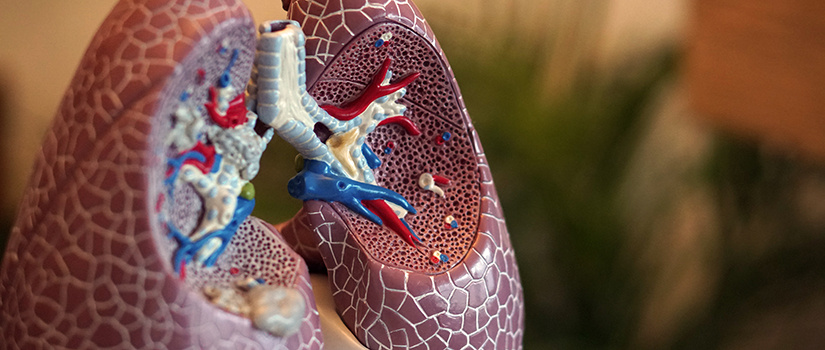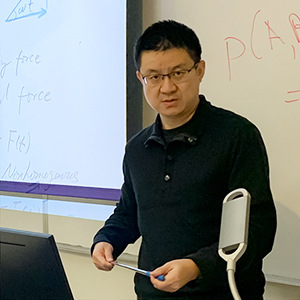With Yi Sun’s help over the past decade, medical researchers are moving toward an innovation that could save thousands of lives each year: the development of 3-D printed artificial organs.
“This is still many years away,” Sun says. “Right now, we’ve been working on a very small part.”
Small, as in at the cellular level.
To create viable organs, researchers need to engineer tissue that will form new blood vessels – a process known as vascularization – an essential process to stay alive in the body.
Researchers across the state have collaborated on this project for years, and Sun joined the work through SC EPSCoR when he came to USC in 2011.
A mathematics professor and researcher, Sun has played an integral in role in the ongoing project by running computational simulations to determine how 3-D printed tissue would function with different variables at play.
“My partners on the tissue fabrication work are from the biomedical engineering field,” Sun says. “From the mathematics side, our team can join their work to do some of the modeling and simulations to help them design the experiments and biomaterials.”
While scientists in every field use computer and data science as tools in their work, what Sun brings to this project as a computational mathematician is his expertise in developing algorithms and coding to combine multiple complex models with hybrid computations.
“We track each cell’s movement, and we also couple other mechanisms into our mathematical model – not just where the cell moves, but what makes the cell move,” Sun says.
In addition to looking at the physical movements of cells, Sun tracks what will happen in each cell’s chemical evolution, giving insight into the new tissue’s development.
By tracking the progress of the cells that make up simulated tissue, Sun and his collaborators can see what would happen over the course of days of real-time experimentation with physical materials.
Mathematical modeling saves costs and resources, among them precious time, bringing the day that much sooner when artificial organs will be able to help those waiting for transplants.
Mathematical modeling to mitigate pandemics
From the formation of new tissue and tracking individual cells, Sun has a broader application in mind for his next mathematical modeling project.
His newest research, funded by a grant from the National Science Foundation and ASPIRE-I fund, will build on his tissue work to look at the spread of COVID-19, epidemics and pandemics in communities.
What does the spread of an infectious disease and the growth of tissue have in common?
For Sun, both present an opportunity to track multiple variables by way of hybrid models using his innovative approach to complex simulations.
“These actually are two totally different mathematical model projects,” Sun says, “but they share the same kind of spirit.”
Recently, Sun has worked with his doctoral student and colleagues to develop mathematical models for traffic patterns and pedestrian flows through a city. Sun saw an opportunity to combine that research with the traditional, population-based model for tracking epidemics.
“The famous model is called SIR, where ‘S’ is susceptible, ‘I’ is infected, and ‘R’ is recovered. It’s just three coupled equations to describe these populations and doesn’t consider the spatial distribution of the people,” Sun says.
“I want to build out a hybrid model of SIR, coupled with the spatial information from the pedestrian models.”
Working from data about the spread of COVID-19, Sun’s work may help inform public health recommendations in future epidemics, so it’s important to arrive at key conclusions quickly.
“Collaborating on these interdisciplinary problems, we want to develop good, efficient ways to do large-scale computations,” Sun says.
Sun has refined a traditional algorithm used in this kind of computation, known as the Monte Carlo method, to arrive at conclusions more quickly without losing much accuracy.
This new version is called the hybrid kinetic Monte Carlo method.
“This is my most powerful computational tool. I want to try to apply this algorithm everywhere.”
Sun’s twist on the Monte Carlo method
Usually, when doing a Monte Carlo simulation, the mathematician will introduce an element of randomness into the computation. This is meant to simulate random chance.
For Sun’s models, however, introducing this random variable often has the opposite effect – creating mathematically impossible scenarios that would waste computational time on events that would never happen in the real world.
To work around that challenge, Sun uses a modified version of the Monte Carlo method to forgo the random variable – a bit unorthodox, but a whole lot faster and still accurate enough.
Sun calls it his “most powerful tool” for a reason. He has been developing and refining this method in research since his days as a doctoral student and he continues to look for new ways to use this tool, like applying it to tracking atomic crystal formation. He can find ways to apply it to almost any problem of this kind.
“I want to build on this framework of ideas to develop new computational schemes and
methods to approach many different problems,” Sun says.
Banner image for illustration only. Photo by Robina Weermeijer on Unsplash.

